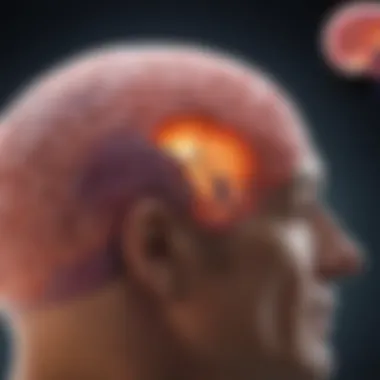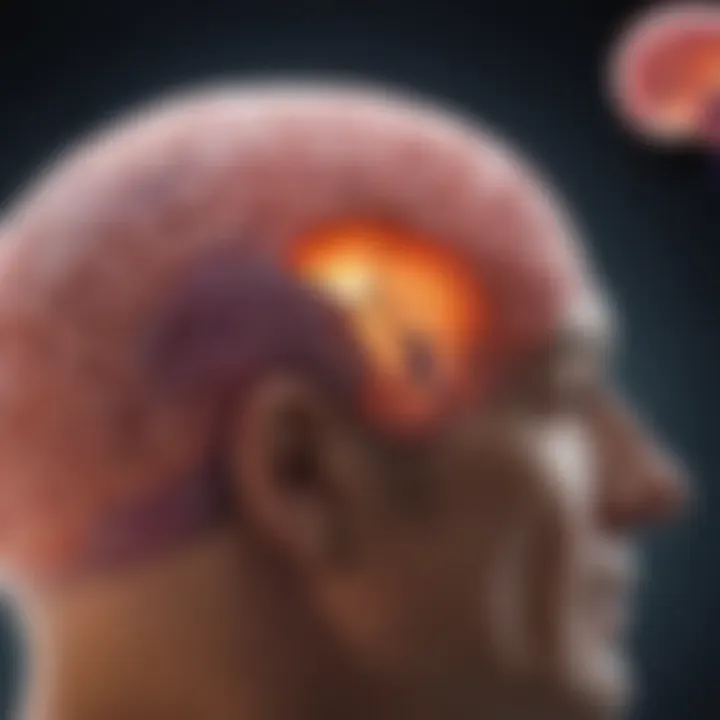Gangliogliomas and Seizures: Unraveling the Link


Intro
Gangliogliomas are a unique type of brain tumor formed from ganglion cells and glial cells. These tumors often appear in the temporal lobe of the brain and can lead to a variety of neurological symptoms, most notably seizures. Understanding the connection between gangliogliomas and the onset of seizures is essential for both diagnosis and treatment. Patients with gangliogliomas frequently experience seizures, which can greatly impact their quality of life. Exploring this connection encompasses a wide range of factors, including tumor pathology, biological behavior, and the various therapeutic strategies employed to mitigate seizure activity.
In this article, we will delve into the intricate relationship between gangliogliomas and seizures. We will examine the characteristics of gangliogliomas, discuss diagnostic approaches, analyze current treatments, and consider the implications of seizure activity in patients with these tumors. The goal is not simply to provide information, but to facilitate a better understanding of this complex issue, ensuring clarity for students, educators, and professionals alike.
Research Overview
To comprehend the intricate relationship between gangliogliomas and seizures, one must first understand the research approaches that have been adopted in this field. Various methodologies are utilized in the study of these tumors, including clinical imaging, histological examination, and patient interviews.
Methodological Approaches
- Clinical Imaging: Advanced imaging techniques such as MRI and CT scans are vital in identifying the presence and extent of gangliogliomas. They allow for the assessment of tumor size and location, providing essential information that can aid in predicting seizure activity.
- Histological Analysis: Examining tissue samples under a microscope helps characterize the tumor at a cellular level. This provides insights into tumor behavior and potential aggressiveness, which can influence seizure occurrence.
- Neurophysiological Studies: Electrophysiological assessments, including EEG monitoring, help document seizure types and frequencies in patients with gangliogliomas. Such studies are crucial for tailoring treatment plans.
Significance and Implications
Understanding the relationship between gangliogliomas and seizures has significant implications for clinical practice. The presence of seizures can often serve as a key indicator for the diagnosis of gangliogliomas. Furthermore, recognizing the underlying mechanisms that contribute to seizures can inform therapeutic decisions. Treatment options may include surgical resection of the tumor and pharmacological intervention to manage seizure activity.
"The connection between gangliogliomas and seizures highlights the need for a comprehensive clinical approach, combining diagnostic imaging, histology, and patient symptomology."
Current Trends in Science
Recent scientific advancements have greatly enhanced the understanding of gangliogliomas and their association with seizures. Innovative techniques and collaborative approaches in research have paved the way for new insights into this challenging area.
Innovative Techniques and Tools
New developments in neurosurgery, such as minimally invasive techniques, have improved the management of gangliogliomas. Intraoperative imaging and monitoring have also advanced, allowing surgeons to better navigate and remove tumors while preserving critical brain functions.
Advancements in genetic and molecular analysis enable researchers to investigate the biological characteristics of gangliogliomas more thoroughly. This can lead to the discovery of potential targeted therapies aimed at reducing seizure frequency and improving patient outcomes.
Interdisciplinary Connections
The interplay of various disciplines in neuroscience, oncology, and neurology has enhanced understanding of gangliogliomas. Collaboration between researchers and practitioners leads to enriched perspectives on diagnosis and treatment. This interdisciplinary approach emphasizes the importance of comprehensive care in addressing patient needs.
Preface to Gangliogliomas
Gangliogliomas are a unique subset of brain tumors, characterized by their distinct cellular composition and an intriguing relationship with seizure activity. Understanding these tumors forms the foundation of this article, as it is crucial for grasping how gangliogliomas influence neurological function, particularly in patients prone to seizures. This section aims to lay the groundwork by presenting critical elements, benefits, and considerations related to gangliogliomas.
Definition and Characteristics
Gangliogliomas are typically classified as low-grade tumors. They contain both glial cells and neuronal components, which is atypical for most brain tumors. The presence of neurons within the tumor differentiates gangliogliomas from other glial tumors. Historically, they are regarded as generally benign but can lead to significant health challenges.
The clinical presentation often varies, with some patients experiencing seizures as the primary symptom. The tumor location within the brain can greatly influence the manifestations and severity of symptoms. Gangliogliomas are often found in the temporal lobe, a region significant for sensory perception and memory formation. This localization also highlights why seizure activity is a common occurrence.
Furthermore, gangliogliomas can be relatively slow-growing, which often allows for a better prognosis, assuming timely detection and intervention. However, their potential for engendering recurrent seizures emphasizes the necessity for a thorough understanding of their nature and implications.
Epidemiology of Gangliogliomas
Gangliogliomas are considered rare, accounting for approximately 1–2% of all central nervous system tumors. Epidemiological studies indicate that they typically present in younger individuals, often in adolescents or young adults. Despite being classified as benign, there can be variances in behavior based on the tumor's histological features.
A significant pattern observed in the epidemiology of gangliogliomas is their slightly higher prevalence in males compared to females. Moreover, studies suggest a potential correlation with developmental disorders, including tuberous sclerosis complex.
The rarity and distinctive characteristics of gangliogliomas necessitate specialized diagnostic and management approaches, particularly regarding seizure management.
This section endeavors to underscore the complexity of gangliogliomas, not just as tumors but as significant contributors to the neurological complications experienced by affected individuals. The context set here is essential for understanding subsequent discussions related to seizures, diagnostics, and therapeutic strategies.
Understanding Seizures
Understanding seizures in the context of gangliogliomas is crucial for various reasons. First, seizures are one of the most common clinical presentations of patients with gangliogliomas. Hence, apprehending the nature of seizures, such as their types and underlying mechanisms, enhances the treatment and management strategies for affected individuals. Seizures can vary widely in presentation, intensity, and frequency, which can significantly influence the quality of life.


Seizures stem from abnormal electrical activity in the brain. When a ganglioglioma develops, it can disrupt normal brain functions, contributing to seizure activity. This link underscores the importance of recognizing different seizure types and their mechanisms. Effective management and treatment rely heavily on a thorough understanding of these elements. Additionally, this knowledge can assist healthcare professionals in developing appropriate diagnostic and therapeutic approaches for patients suffering from gangliogliomas.
In summary, understanding seizures allows us to uncover essential insights about gangliogliomas and improve patient care. It also opens avenues for research that can lead to better management protocols and potentially new treatments.
Types of Seizures
Seizures can be categorized into various types, each exhibiting distinct characteristics. The two main classifications are focal seizures and generalized seizures.
- Focal Seizures: These seizures initiate in a specific area of the brain. They can further be divided into:
- Generalized Seizures: These seizures affect both hemispheres of the brain from the onset. They include:
- Focal Aware Seizures: The patient remains conscious and aware during the episode.
- Focal Impaired Awareness Seizures: Consciousness is altered, leading to confusion or unresponsiveness.
- Tonic-Clonic Seizures: Formerly known as grand mal seizures, these involve a mix of stiffening (tonic) and jerking movements (clonic).
- Absence Seizures: Brief lapses in consciousness, often mistaken for daydreaming.
Understanding these types can aid in identifying patient experiences and tailoring treatments effectively, particularly in the context of gangliogliomas, where seizure types may align with tumor location.
General Mechanisms of Seizures
The mechanisms behind seizures involve a complex interplay of neuronal activity and neurotransmitter function. Several key factors contribute to the seizure process:
- Imbalance of Neurotransmitters: An imbalance between excitatory neurotransmitters, like glutamate, and inhibitory ones, like gamma-aminobutyric acid (GABA), can lead to increased neuronal excitability.
- Altered Neuronal Circuitry: The presence of a ganglioglioma can disrupt normal brain circuits, leading to abnormal electrical discharges.
- Neuroinflammation: Tumor growth may cause inflammatory responses in the brain, further altering neuronal behavior.
Understanding these mechanisms is vital for developing targeted treatments. Identifying the specific dysfunction may help formulate more effective management strategies.
Pathophysiology of Gangliogliomas
Understanding the pathophysiology of gangliogliomas is crucial for grasping how these tumors can influence seizure activity. Gangliogliomas are unique neoplasms that often arise in the central nervous system, displaying both neuronal and glial components. The interplay between these cell types is vital for the clinical implications of gangliogliomas, especially as they relate to seizure occurrence.
Cellular Composition
Gangliogliomas are composed of a combination of tumor cells derived from both neurons and glial cells. The neuronal cells are often mature and resemble normal neurons, while the glial cells can include astrocytes, oligodendrocytes, and ependymal cells. This cellular composition plays a significant role in the tumor's behavior. The dysregulation of normal cellular signaling and growth pathways leads to abnormal proliferation. Research suggests that mutations in specific genes, such as BRAF, are common in gangliogliomas. These mutations may contribute to their tendency to promote epileptic activity through altered metabolic processes.
Additionally, the presence of neuronal cells can create hyperexcitable environments that facilitate seizure generation. Their anatomical arrangement and functional interactions can propagate electrical signals more easily, leading to an increased risk of seizures. Understanding this composition and its implications helps medical professionals approach treatment options with more insight.
Growth Patterns and Localization
The growth patterns of gangliogliomas are often indolent, occurring over a prolonged period. However, the localization of these tumors significantly influences their clinical manifestations. Commonly, they are found in the temporal lobe, which is an area closely associated with seizure control and cognitive functions. This location enhances the chance of seizure activity, as the seizures can arise from nearby normal structures, exacerbating the clinical picture.
The pattern of local invasion also varies. Gangliogliomas can grow infiltratively, often making complete surgical resection challenging. This invasive nature not only complicates treatment but also raises the likelihood of seizures due to pressure on adjacent brain areas. The localization is also associated with the seizure types that may be observed, as different brain regions are responsible for distinct seizure manifestations.
In summary, the pathophysiology of gangliogliomas centers around their unique cellular makeup and growth characteristics. Both of these elements are significant in their relationship to seizures. A detailed understanding of these aspects can guide clinicians in diagnosis, treatment options, and anticipating patient outcomes.
The Link Between Gangliogliomas and Seizures
Understanding the relationship between gangliogliomas and seizures is critical for grasping how these brain tumors affect patient outcomes. Gangliogliomas are often associated with seizure activity due to their location and cellular makeup in the brain. The presence of these tumors can lead to significant alterations in the electrical activity of neurones, which in turn can precipitate seizure episodes.
Seizures can profoundly affect the quality of life for patients with gangliogliomas. Recognizing the specific connections facilitates improved management strategies. The aim is to not only control seizure activity but also to address the underlying pathophysiology of the tumor itself.
It's important to be aware of the particular types of seizures that may be associated with gangliogliomas. Certain clinical presentations can indicate functionality or irritation of specific brain regions linked to the tumor. These associations highlight the need for a detailed understanding of neuronal circuits and how they might be disrupted.
Mechanisms of Seizure Induction
The mechanisms through which gangliogliomas induce seizures are complex and multifactorial. One of the primary factors is the disruption of normal neuron function. When gangliogliomas grow, they can invade surrounding brain tissue, leading to an imbalance in excitatory and inhibitory signals. This dysfunction arises due to the tumor’s unique cellular characteristics, which often include both glial and neuronal components.
Some possible mechanisms that may contribute to seizure induction are:
- Abnormal electrical activity: Tumor cells can generate irregular electrical signals, which may spread to adjacent normal brain cells.
- Altered ion channel function: Changes in ion channels can affect neuron excitability, contributing to the likelihood of seizure activity.
- Neuroinflammation: Tumors can provoke inflammatory responses, which may increase seizure susceptibility by modifying the local environment.
Addressing these mechanisms not only helps manage seizures effectively but also may influence treatment decisions. Understanding the triggers for seizure activity can lead to targeted pharmacological options and tailored therapeutic strategies.


Clinical Presentations of Seizures
Seizures linked to gangliogliomas present a wide range of clinical manifestations. Patients often describe their episodes differently, depending on the tumor's location, size, and infiltrative characteristics. Common clinical presentations include:
- Focal seizures: Often arise if the tumor affects a specific region, leading to symptoms that may involve singular body parts or certain functionalities like speech.
- Generalized seizures: These may occur, but are less common. They involve widespread brain regions and can manifest as convulsive activity.
- Psychic symptoms: Some patients experience aura prior to seizures, which might include visual or auditory sensations, altering their awareness of surroundings.
Seizure activity requires careful monitoring and evaluation. The frequency and intensity of seizures may vary greatly, requiring individualized management plans. Clinicians should consider a combination of clinical observations and diagnostic tools to effectively assess seizure types and their link to gangliogliomas.
Diagnostic Evaluation
The process of diagnostic evaluation is pivotal in understanding the connection between gangliogliomas and seizures. Accurate diagnosis plays a crucial role in formulating effective treatment strategies, as the symptoms can be similar to those caused by other types of brain tumors and neurological conditions. A thorough evaluation helps in identifying the specific nature of a ganglioglioma, its location, and the extent to which it influences seizure activities.
Importance of Diagnostic Evaluation
Diagnostic evaluation encompasses various components that work synergistically to offer insights into a patient's condition. One of the primary goals is to determine the presence of ganglioglioma and its characteristics. This includes information on tumor size, cellular makeup, and adjacent structures. Such details are essential to predict how the tumor might affect the brain's electrical activity, which is critical in the context of seizures.
The evaluation process can also detect any changes over time. Monitoring these changes is vital to assess the effectiveness of treatment and to adjust the therapeutic approaches accordingly. A robust diagnostic framework ensures that medical professionals can provide the most informed care, optimizing health outcomes for patients.
Here are some beneficial aspects of a thorough diagnostic evaluation:
- Informs Treatment Decisions: Accurate diagnosis guides the selection of suitable treatment options.
- Facilitates Prognosis: Understanding tumor characteristics can aid in predicting the patient’s long-term outlook.
- Enhances Patient Management: Ongoing monitoring enables healthcare providers to respond promptly to any emerging concerns.
- Reduces Diagnostic Errors: A systematic evaluation helps to differentiate between gangliogliomas and other conditions.
Imaging Techniques
Imaging techniques are the cornerstone of diagnostic evaluation. They offer visual insights into the brain’s structure and identify the presence and characteristics of gangliogliomas. The most common modalities employed include magnetic resonance imaging (MRI) and computed tomography (CT) scans.
- Magnetic Resonance Imaging (MRI): MRI is highly effective for brain imaging. It provides detailed images of soft tissues, making it useful for visualizing gangliogliomas. Enhanced MRI techniques, such as functional MRI, can additionally depict altered brain function related to seizure activity.
- Computed Tomography (CT) Scans: CT scans are quicker and may be used in acute settings. However, they are less sensitive than MRI in detecting brain tumors. They can, nonetheless, be useful in evaluating the extent of injury or detecting bleeding, which may accompany seizures.
- Positron Emission Tomography (PET): PET scans assess brain metabolism and can help in distinguishing between tumor types, guiding further interventions.
- Single-photon emission computed tomography (SPECT): SPECT is beneficial for studying brain function. It may reveal areas of altered activity that correlate with seizure foci.
Accurate imaging is essential to diagnose gangliogliomas effectively, as it directly informs treatment strategies and potential outcomes.
Electroencephalography (EEG)
Electroencephalography (EEG) is an invaluable diagnostic tool that records the electrical activity of the brain. It plays a critical role in assessing seizure activity, particularly in patients with gangliogliomas. Through the placement of electrodes on the scalp, EEG captures brain waves, enabling the identification of seizure patterns and localized abnormalities.
Benefits of EEG in Ganglioglioma Diagnosis
- Seizure Localization: EEG can pinpoint areas of the brain that are generating abnormal electrical activity associated with seizures, which can inform surgical planning.
- Characterization of Seizures: It helps in determining the type and frequency of seizures, which can vary among patients.
- Monitoring Treatment Efficacy: Continuous EEG can monitor seizure activity progressively, aiding in the evaluation of treatment responses over time.
Considerations in EEG Interpretation
EEG findings must be interpreted cautiously. The presence of abnormalities does not always correlate with the physical presence of a tumor. Various factors, including medication effects and other neurological conditions, can influence EEG results. Hence, a comprehensive interpretation is necessary for accurate clinical decision-making.
Treatment Options
Understanding the treatment options for gangliogliomas is crucial to managing seizures in affected patients. The treatment plan often requires a systematic approach that combines various modalities tailored to the characteristics of the tumor and the needs of the patient. The three main avenues of treatment include surgical intervention, pharmacological management, and radiation therapy. Each of these has its specific advantages and considerations that impact the overall effectiveness of the management strategy.
Surgical Intervention
Surgical intervention is often considered the primary treatment for gangliogliomas, especially when the tumor is accessible and can be safely resected. The goal of surgery is to remove as much of the tumor as possible while minimizing damage to adjacent brain tissues. This can lead to a significant reduction in seizure frequency and improvement in the patient's quality of life. Early intervention is typically recommended since the longer the tumor persists, the greater the likelihood of neurological deficits.
However, surgery is not without risks. Potential complications can include infection, bleeding, and neurological impairments. Furthermore, in certain cases where the tumor is deeply embedded in critical areas of the brain, total resection may not be feasible. In such situations, a conservative approach with ongoing observation may be adopted.
Pharmacological Management
Pharmacological management plays a key role, particularly for patients who are not candidates for surgery or for whom surgical options are limited. Anti-epileptic drugs (AEDs) are usually the first line of defense in managing seizures. These medications can help to stabilize neuronal activity and reduce the frequency and severity of seizure episodes. Options such as levetiracetam, lamotrigine, and carbamazepine are common choices.
It is worth noting that the choice of medication may be influenced by several factors including the patient’s age, overall health, potential side effects, and how well they respond to specific drugs. Monitoring is essential, as adjustments might be necessary to optimize seizure control and minimize adverse effects. Additionally, patient education regarding adherence to medication regimens is vital for achieving the best possible outcomes.
Radiation Therapy


Radiation therapy is another treatment modality that can be utilized, particularly in cases where surgery is not an option or when residual tumor remains post-surgery. This approach aims to control tumor growth by damaging the DNA in the tumor cells, thus preventing their ability to proliferate. Single-dose radiation or fractionated radiation therapy are common protocols used.
While radiation can effectively reduce tumor size and control symptoms, it may also lead to side effects such as fatigue, headaches, and potential damage to surrounding healthy brain tissue. The benefits must be weighed against these risks, and decisions are often made collaboratively by patient and healthcare providers.
Important: The treatment of gangliogliomas always necessitate a multidisciplinary approach. Involving neurologists, oncologists, and neurosurgeons can ensure comprehensive care tailored to patients' needs.
Patient Management and Follow-Up
Patient management and follow-up are crucial components in the overall treatment of individuals with gangliogliomas, particularly with regards to their seizure activity. Understanding how to monitor and respond to seizures is vital for improving the patients’ quality of life and ensuring optimal care. This section will explore the specific elements and benefits associated with effective patient management and continuous follow-up for those affected by gangliogliomas.
Monitoring Seizure Activity
Monitoring seizure activity involves employing various techniques to track both the frequency and nature of seizures experienced by patients. Continuous observation is key, as it helps healthcare providers identify patterns in seizure occurrence and their potential triggers.
Some of the primary methods used for monitoring include:
- Patient Reports: Patients and caregivers should be encouraged to keep a detailed log of seizure events, noting the time, duration, and nature of each episode. This first-hand documentation aids in assessing the effectiveness of prescribed treatments.
- Video EEG Monitoring: This method combines electroencephalography with video recording to capture seizure activity. By correlating EEG patterns with physical manifestations, practitioners can make more informed decisions regarding treatment adjustments.
- Wearable Technology: Advancements in technology have led to the development of devices that can monitor physiological indicators of seizures, such as heart rate and movement. These devices can send alerts, thereby providing immediate data to the healthcare team.
Regular monitoring allows for timely intervention in case of increased seizure activity. Adjustments to treatment plans may be necessary based on observed data.
Long-Term Outcomes
Long-term outcomes for patients with gangliogliomas largely depend on effective management of both the tumor and associated seizure activity. As gangliogliomas can vary in aggressiveness and response to treatment, monitoring provides crucial insight into the evolution of the disease and patient’s condition.
Key considerations include:
- Seizure Control: Successfully managing seizure frequency can significantly affect patients’ daily functioning. Continuous follow-up allows for the assessment of pharmacological treatment efficacy and the possibility of surgical options if seizures remain uncontrolled.
- Quality of Life: A focus on long-term management also addresses the psychosocial aspects of living with a chronic condition. Regular follow-ups offer opportunities for emotional support, education, and resources to enhance the quality of life for patients and their families.
- Rehabilitation Needs: Some patients may require rehabilitation services after seizure events or treatment interventions. Planning for these needs early can improve overall outcomes and aid in recovery.
Furthermore, maintaining consistent communication between the health care team and patient is vital. It ensures that any emerging concerns can be addressed promptly, improving the long-term prognosis for individuals living with gangliogliomas.
"Effective patient management and follow-up can make a substantial difference in the quality of life for individuals affected by gangliogliomas and their families."
By prioritizing rigorous monitoring and adaptive management strategies, healthcare professionals can navigate the complexities associated with gangliogliomas while supporting patients on their journey to stability and well-being.
Recent Research Insights
Recent research into gangliogliomas and their connection to seizures has opened numerous avenues for understanding both conditions more profoundly. This body of work is essential for students, researchers, educators, and professionals alike, as it unravels complexities that were previously less understood. The continued exploration in this area can lead to significant advancements in treatment and diagnostic strategies, benefiting a broad range of stakeholders.
Advancements in Treatment
Recent years have seen notable advancements in treatment modalities for gangliogliomas that correlate with a better understanding of seizure management. For instance, minimally invasive surgical techniques have become more common. Such practices reduce recovery time and may limit the potential for adverse side effects traditionally associated with larger surgical interventions.
Additionally, the development of targeted therapies aims to address specific molecular pathways involved in ganglioglioma proliferation. This personalized approach could improve treatment outcomes for patients experiencing seizures linked to these tumors. The research surrounding the use of novel medications, including epileptic drugs that specifically target seizure activity, showcases a commitment to enhancing patient care.
- Novel Therapeutics: Specific agents like lamotrigine can be effective in controlling seizures.
- Surgical Innovations: Techniques such as laser interstitial thermal therapy are gaining traction.
- Combining Therapies: Multi-modal treatment can offer better control over both tumor growth and seizure activity.
Emerging Biomarkers
Identifying emerging biomarkers for gangliogliomas can revolutionize how clinicians approach both diagnosis and treatment. Biomarkers can offer insight into tumor behavior, potential for seizure activity, and response to treatment. For example, research is ongoing into genetic mutations or specific protein expressions characteristic of gangliogliomas.
"The identification of reliable biomarkers could make it possible to tailor treatment plans more effectively, leading to improved patient outcomes."
- Genetic Markers: Specific mutations can signify tumor aggressiveness.
- Protein Expressions: Certain proteins may correlate with seizure frequency.
- Clinical Trials: Many are focusing on how these biomarkers can predict treatment success.
Ending
The conclusion serves a critical role in synthesizing the information presented throughout the article. By summarizing the findings, readers gain a concise overview of the key points discussed regarding gangliogliomas and their relation to seizure activity. This process not only reinforces knowledge but also emphasizes the importance of understanding the connection between tumor characteristics and seizure mechanisms.
Summary of Findings
In reviewing the intricate relationship between gangliogliomas and seizures, several significant insights emerge. First, gangliogliomas are unique brain tumors that often manifest with various seizure types due to their location and pathological features. Research indicates that as the tumor grows, it may irritate surrounding brain tissue, leading to increased seizure activity. Furthermore, imaging techniques and electroencephalography are essential for accurate diagnosis and monitoring. Treatment options are diverse, comprising surgical removal, pharmacological management, and, in some cases, radiation therapy. Effective management of seizures becomes a multi-faceted approach that includes careful assessment and tailored treatment plans for patients.
Future Perspectives
The landscape of treating seizures associated with gangliogliomas continues to evolve. Emerging research is focused on identifying specific biomarkers that can guide therapeutic decisions. Furthermore, advancements in minimally invasive surgical techniques offer new hope for patients with inoperable tumors. The development of novel pharmacological agents, designed to more effectively target seizure pathways, is also on the horizon. As understanding deepens regarding the molecular and genetic underpinnings of gangliogliomas, there is potential for more effective interventions that address both the tumor itself and its seizure-related consequences.



